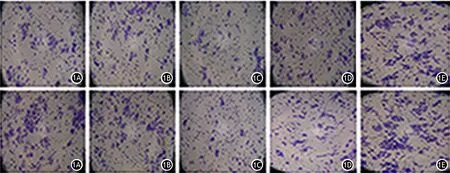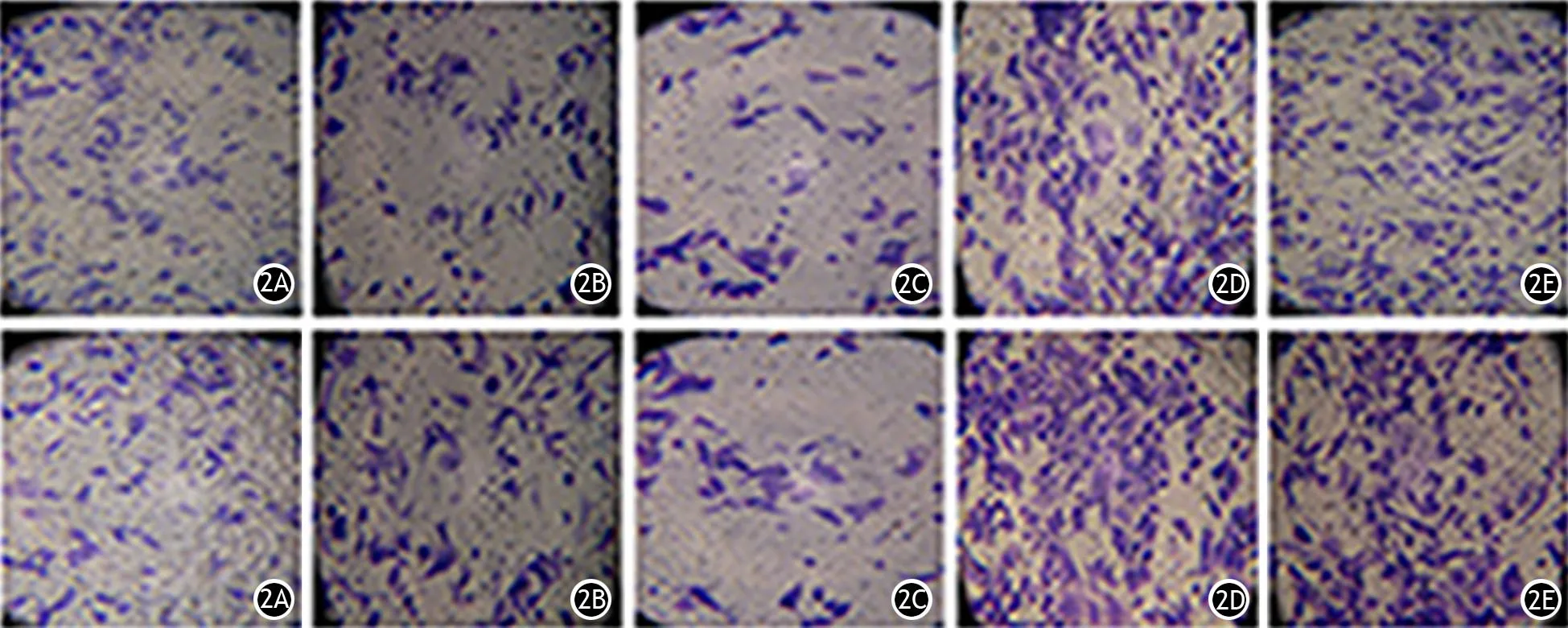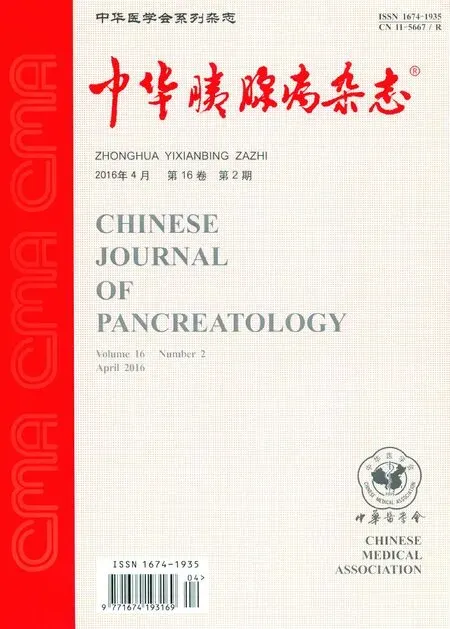联合使用miR-34a及miR-let7对胰腺癌细胞生物学特性的影响
刘宇亭 沈祥国 苏长青 孙斌 李兆申 徐灿
200433 上海,第二军医大学长海医院消化内科(刘宇亭、沈祥国、李兆申、徐灿);第二军医大学东方肝胆外科医院分子肿瘤研究室(苏长青、孙斌);东部战区空军机关医院(刘宇亭)
·论著·
联合使用miR-34a及miR-let7对胰腺癌细胞生物学特性的影响
刘宇亭沈祥国苏长青孙斌李兆申徐灿
200433上海,第二军医大学长海医院消化内科(刘宇亭、沈祥国、李兆申、徐灿);第二军医大学东方肝胆外科医院分子肿瘤研究室(苏长青、孙斌);东部战区空军机关医院(刘宇亭)
【摘要】目的探讨联合使用两种具有抑癌作用的microRNA(miRNA)同时转染人胰腺癌细胞对其生物学特性的影响。方法采用脂质体法将miR-34a及miR-let7单独或同时转染胰腺癌PANC1、SW1990细胞及正常胰腺腺泡AR42J细胞,以转染阴性对照miRNA(miR-NC)组及未转染组作为对照。应用qRT-PCR法检测各组细胞miR-34a及miR-let7的表达,MTT法检测细胞增殖,Transwell小室检测细胞迁移和侵袭能力,流式细胞仪检测细胞凋亡。结果MiR-34a转染组、miR-let7转染组、双转染组细胞的miR-34a、miR-let7表达水平均较miR-NC转染组及未转染组显著上调,差异有统计学意义(P值均<0.05),表明miRNA成功转染了细胞。双转染组的PANC1、SW1990细胞增殖活性分别为(0.665±0.010)%、(0.638±0.030)%,较miR-NC转染组的(0.974±0.030)%、(0.971±0.050)%,miR-let7转染组的(0.888±0.050)%、(0.863±0.060)%显著被抑制,差异有统计学意义(P值均<0.05),较miR-34a转染组的(0.795±0.060)%、(0.793±0.060)%下降,但差异无统计学意义。AR42J细胞的增殖活性无显著变化,差异无统计学意义。PANC1细胞miR-34a转染组、miR-let7转染组的穿膜细胞数分别为(103.70±3.28)、(100.70±1.76)个/200倍视野,较miR-NC转染组的(231.30±2.60)个/200倍视野及未转染组的(153.70±2.60)个/200倍视野显著减少,双转染组穿膜细胞数为(61.67±3.18)个/200倍视野,又较两个单转染组显著减少,差异均有统计学意义(P值均<0.01)。细胞迁移实验与侵袭实验的结果一致。SW1990细胞侵袭及迁移能力的变化与PANC1一致。PANC1细胞的miR-34a转染组、miR-let7转染组、双转染组、miR-NC转染组、未转染组的细胞凋亡率分别为(16.66±1.27)%、(15.46±0.33)%、(23.35±1.80)%、(9.33±0.31)%、(8.83±0.36)%。两单转染组的细胞凋亡率较miR-NC转染组、未转染组显著增加;双转染组又较miR-let7组显著增加,差异有统计学意义(P值均<0.05),而双转染组与miR-34a转染组的差异无统计学意义。结论双转染的胰腺癌细胞增殖活性、细胞迁移和侵袭力均较单转染细胞显著下降,而细胞凋亡率较单转染细胞显著增加,双转染能够发挥更加显著的协同抗肿瘤作用。
【关键词】胰腺肿瘤;细胞系,肿瘤;miR-34a;miR-let7;转染;分子生物学
胰腺癌恶性程度高,手术切除率低,预后差,总体5年生存率不到5%[1]。肿瘤基因治疗及免疫治疗的出现为人们攻克胰腺癌提供了新的思路和视野。microRNA(miRNA)是一种高度保守的短链非编码RNA,能够在转录后水平调节基因的表达。到目前为止,已有超过1800余种miRNA被陆续报道[2-4],且大量的研究已经证实miRNA的异常表达与肿瘤的发生相关[5],从而为肿瘤的治疗提供了新的方向。有研究报道,miR-34a的靶基因在调节细胞凋亡、细胞周期阻滞、DNA修复、血管生成等方面有非常重要的作用,在胰腺癌中表达缺失或者明显下调,发挥抑癌基因的作用[6-7]。miR-let7存在于正常胰腺腺泡细胞,在低分化胰腺癌组织中表达缺失,提高胰腺癌细胞株miR-let7的表达水平可显著抑制癌细胞增殖[8]。因此本研究联合使用两种miRNA转染胰腺癌细胞,观察其对胰腺癌细胞增殖的影响,为胰腺癌的治疗提供新的思路。
材料与方法
一、材料
人胰腺癌细胞系PANC1、SW1990细胞及正常胰腺腺泡细胞AR42J由第二军医大学附属长海医院消化内科实验室提供。高糖DMEM培养基和胎牛血清购自美国Gibico公司,miR-34a、miR-let7 mimic及阴性对照miRNA (miR-NC)由广东锐博技术有限公司合成,LipofectamineTM2000试剂和RNA抽提试剂Trizol购自美国Invitrogen公司,实时荧光定量PCR试剂盒购自Applied Biosystems公司,MTT试剂盒购自美国Sigama公司,Transwell小室购自美国Millipore公司,聚碳酸酯膜基质胶和细胞凋亡检测试剂盒购自美国BD公司。
二、方法
1.细胞培养及miRNA转染:胰腺癌PANC1细胞及SW1990细胞由高糖DMEM培养基(含10%FBS)培养,正常胰腺腺泡细胞AR42J由1640(含10% FBS)培养基培养,取对数生长期细胞接种于培养板内。实验分5组:miR-34a转染组、miR-let7转染组、miR-34a和miR-let7双转染组、miR-NC转染组及未转染对照组,每组设6个复孔,按miRNA mimics及LipofectamineTM2000试剂说明书操作。转染后用无血清培养基饥饿处理细胞4 h,更换含10%FBS的DMEM培养液继续培养24 h进行下一步实验。
2.qRT-PCR法检测细胞miRNA表达:取上述各组转染24 h细胞,应用Trizol收集细胞总RNA,在紫外分光光度仪上检测RNA浓度及纯度后采用逆转录试剂盒反转录获得cDNA,采用实时荧光定量PCR试剂盒进行扩增,以U6为内参。PCR反应条件:95℃ 10 min,95℃ 15 s、60℃ 30 s、72℃ 30 s,40个循环。所有反应设3个复孔。由仪器自带软件获取Ct值,以公式2-ΔΔCt计算mRNA相对表达量。
3.MTT法检测细胞增殖活性:取上述各组转染24 h细胞,加MTT 20 μl继续培养4 h,加DMSO 150 ml终止反应,上酶标仪检测490 nm处吸光度值(A490值),以单加培养液的孔调零。细胞增殖率=实验组A490值/对照组A490值×100%。实验重复3次,取均值。
4.Transwell小室检测细胞的迁移、侵袭力:预先将基质胶与DMEM 培养液按1∶5混合稀释后,以100 μl/室铺入小室隔膜上,37℃过夜风干、凝固。取上述各组转染细胞,上室加4×104个细胞,容积200 μl。下室加500 μl含20% FBS的DMEM培养液,培养24 h后用结晶紫染色20~30 min,PBS洗涤后用棉签轻轻擦拭小室内未穿膜细胞,显微镜下取3个200倍视野,计数穿膜细胞数。实验重复3次,取均值。参考骆广涛等[9]方法,检测细胞迁移能力,Transwell小室隔膜不铺基质胶。
5.流式细胞仪检测细胞凋亡:取对数生长期各组转染细胞,用不含EDTA的胰酶消化,收集细胞后用预冷PBS洗两遍,1 500 r/min离心10 min,用Binding Buffer重悬,置冰上加入Annexin V轻混匀后加入PI染色,上流式细胞仪测细胞凋亡。实验重复3次。
三、统计学处理

结果
一、MiRNA转染细胞的鉴定
PANC1、SW1990、AR42J细胞转染miRNA后,miR-34a转染组、双转染组细胞的miR-34a表达水平均较miR-let7转染组、miR-NC转染组及未转染组显著上调;miR-let7转染组、双转染组细胞的miR-let7表达水平均较miR-34a转染组、miR-NC转染组、未转染组显著上调,差异均有统计学意义(P值均<0.05)。见表1、2。表明miRNA成功转染了细胞。
二、各组转染细胞增殖的变化
双转染组的PANC1、SW1990细胞增殖活性较miR-NC转染组、miR-let7转染组显著被抑制,差异均有统计学意义(P值均<0.05),而与miR-34a转染组的差异无统计学意义。AR42J细胞各转染组间的增殖活性无显著变化,差异无统计学意义(表3)。

表1 3种细胞系中各转染组miR-34a的相对表达量

表2 3种细胞系中各转染组miR-let7的相对表达量
三、各组转染细胞迁移和侵袭力的变化
胰腺癌PANC1细胞及SW1990细胞的miR-34a转染组及miR-let7转染组的穿膜细胞数较miR-NC转染组及未转染组显著减少,双转染组的穿膜细胞数又较两个单转染组显著减少,差异均有统计学意义(P值均<0.01)。见图1、2,表4、5。提示同时转染miR-34a及miR-let7能够更显著地抑制胰腺癌细胞的侵袭及迁移能力。
四、各组转染细胞的凋亡变化
胰腺癌PANC1细胞的miR-34a转染组、miR-let7转染组、双转染组、miR-NC转染组、未转染组的细胞凋亡率分别为(16.66±1.27)%、(15.46±0.33)%、(23.35±1.80)%、(9.33±0.31)%、(8.83±0.36)%(图3)。miR-34a转染组、miR-let7转染组的细胞凋亡率较miR-NC转染组、未转染组显著增加;双转染组又较miR-let7转染组显著增加,差异有统计学意义(P值均<0.05),而与miR-34a转染组的差异无统计学意义,提示双转染两种miRNA能进一步提高胰腺癌细胞的凋亡率。

表3 3种细胞系中各转染组细胞增殖活性±s)

图1 miR-34a转染组(1A)、miR-let7转染组(1B)、双转染组(1C)、miR-NC转染组(1D)、未转染组(1E)PANC1细胞的迁移(上)和侵袭能力(下)变化(×200)

图2 miR-34a转染组(2A)、miR-let7转染组(2B)、双转染组(2C)、miR-NC转染组(2D)、未转染组(2E)SW1990细胞的迁移(上)和侵袭能力(下)变化(×200)

细胞系miR-34a转染组miR-let7转染组双转染组miR-NC转染组未转染组PANC1103.70±3.28100.70±1.7661.67±3.18231.30±2.60153.70±2.60SW199094.67±3.18117.00±4.5051.00±2.08131.30±4.37160.70±4.63

表5 细胞迁移实验中各转染组穿过小室膜的细胞数(个/200倍视野,±s)

图3 PANC1细胞的miR-34a转染组(3A)、miR-let7转染组(3B)、双转染组(3C)、miR-NC转染组(3D)、未转染组(3E)的细胞凋亡
讨论
近年来随着分子生物学领域的快速发展,胰腺癌的早诊、早治已受到广泛重视,针对胰腺癌分子水平的生物治疗技术也取得了一定进展,为胰腺癌的治疗提供了更新的理论基础和实践工具。尽管如此,多数新疗法依然未得到广泛认可,致使胰腺癌的早诊、早治依然停留在临床前研究阶段,胰腺癌患者的生存率并无显著改善[10]。究其原因,一方面在于肿瘤的发生、发展机制并不十分明确,另一方面在于多数分子靶向治疗往往针对单一靶点,而未形成协同的抗肿瘤治疗网络,以致抗肿瘤效果不理想。
MicroRNA是一种内源性的小分子非编码RNA,在转录后水平对细胞新陈代谢的多个环节进行调控。其表达谱的改变在胰腺癌细胞的增殖、凋亡、侵袭、分化等过程中发挥重要作用,与胰腺癌的发生、发展、预后等有着密切的联系。有些miRNA,例如miR-34a、miR-203、miR-124、miR-let7在胰腺癌中表达降低,发挥抑癌基因作用[11-12],而另外一些miRNA,如miR-10a、miR-10b、miR-198、miR-21在胰腺癌组织中高表达,发挥癌基因的作用[13-14]。文献报道,miR-34a在胰腺癌中表达缺失或明显下调发挥着抑癌基因的作用,其靶基因CDK4、cyclins及E2F在调节细胞周期、细胞凋亡、DNA修复中有非常重要的作用[6,15-16]。Lize等[16]报道,miR-let7c及miR-let7f表达在人胰腺癌的穿刺标本中明显降低,提高胰腺癌细胞株miR-let7的表达可显著抑制癌细胞增殖[8]。miR-let7还与结肠癌、肝癌等有关[17],能够抑制肿瘤细胞增殖,其作用可能与Ras、HMGA2和CRD-BP/IMP1的表达相关[18-20]。将miR-34a作用于胰腺癌细胞可抑制其皮下移植瘤的生长[21],利用质粒或慢病毒携带miRNA感染胰腺癌细胞增强其miR-let7的表达,能显著抑制癌细胞的增殖[8]。Lou等[22]报道,通过溶瘤腺病毒共表达miR-34a及IL-24能够发挥协同抗肿瘤活性,显著提高二者抗肿瘤作用。因此,本研究同时使用两种具有抑癌作用的miR-34a及miR-let7 转染胰腺癌细胞,结果显示双转染细胞增殖活性、细胞迁移和侵袭力均较单转染细胞显著下降,而细胞凋亡率较单转染细胞显著增加,能够发挥更加显著的协同抗肿瘤作用,为胰腺癌的治疗提供新的思路。
参考文献
[1]Yang L, Yang H, Li J, et al. ppENK gene methylation status in the development of pancreatic carcinoma[J]. Gastroenterol Res Pract, 2013, 2013: 130927.DOI:10.1155/2013/130927.
[2]Singh PK, Brand RE, Mehla K. MicroRNAs in pancreatic cancer metabolism[J]. Nat Rev Gastroenterol Hepatol, 2012, 9(6): 334-344.DOI:10.1038/nrgastro.2012.63.
[3]Zhang L, Jamaluddin MS, Weakley SM, et al. Roles and mechanisms of microRNAs in pancreatic cancer[J]. World J Surg, 2011, 35(8): 1725-1731.DOI:10.1007/s00268-010-0952-z.
[4]Du Y, Liu M, Gao J, et al. Aberrant microRNAs expression patterns in pancreatic cancer and their clinical translation[J]. Cancer Biother Radiopharm, 2013, 28(5): 361-369.
[5]Di Leva G, Croce CM. miRNA profiling of cancer[J]. Curr Opin Genet Dev, 2013, 23(1): 3-11.DOI:10.1016/j.gde.2013.01.004.
[6]Nana-Sinkam SP, Croce CM. Clinical applications for microRNAs in cancer[J]. Clin Pharmacol Ther, 2013, 93(1): 98-104.DOI:10.1038/clpt.2012.192.
[7]Tazawa H, Tsuchiya N, Izumiya M, et al. Tumor-suppressive miR-34a induces senescence-like growth arrest through modulation of the E2F pathway in human colon cancer cells[J]. Proc Natl Acad U S A, 2007, 104(39): 15472-15477.DOI:10.1073/pnas.0707351104.
[8]Torrisani J, Bournet B, du Rieu MC, et al. let-7 MicroRNA transfer in pancreatic cancer-derived cells inhibits in vitro cell proliferation but fails to alter tumor progression[J]. Hum Gene Ther, 2009, 20(8): 831-844.DOI:10.1089/hum.2008.134.
[9]骆广涛,王本忠. miRNA-4465过表达对乳腺癌MDA-MB-231细胞迁移侵袭的影响及其机制[J]. 安徽医科大学学报, 2015, 50(11): 1570-1573.
[10]Michl P, Gress TM. Current concepts and novel targets in advanced pancreatic cancer[J]. Gut, 2013, 62(2): 317-326.DOI:10.1136/gutjnl-2012-303588.
[11]Xu D, Wang Q, An Y, et al. MiR203 regulates the proli-feration, apoptosis and cell cycle progression of pancreatic cancer cells by targeting Survivin[J]. Mol Med Rep, 2013, 8(2): 379-384.DOI:10.3892/mmr.2013.1504.
[12]Frampton AE, Krell J, Jamieson NB, et al. microRNAs with prognostic significance in pancreatic ductal adenocarcinoma: A meta-analysis[J]. Eur J Cancer, 2015, 51(11): 1389-1404.DOI:10.1016/j.ejca.2015.04.006.
[13]Ohuchida K, Mizumoto K, Lin C, et al. MicroRNA-10a is overexpressed in human pancreatic cancer and involved in its invasiveness partially via suppression of the HOXA1 gene[J]. Ann Surg Oncol, 2012, 19(7): 2394-2402.DOI:10.1245/s10434-012-2252-3.
[14]Vychytilova-Faltejskova P, Kiss I, Klusova S, et al. MiR-21, miR-34a, miR-198 and miR-217 as diagnostic and prognostic biomarkers for chronic pancreatitis and pancreatic ductal adenocarcinoma[J]. Diagn Pathol, 2015, 10: 38.DOI:10.1186/s13000-015-0272-6.
[15]Antonini D, Russo MT, De Rosa L, et al. Transcriptional repression of miR-34 family contributes to p63-mediated cell cycle progression in epidermal cells[J]. J Invest Dermatol, 2010, 130(5): 1249-1257.DOI:10.1038/jid.2009.438.
[16]Lize M, Pilarski S, Dobbelstein M. E2F1-inducible microRNA 449a/b suppresses cell proliferation and promotes apoptosis[J]. Cell Death Differ, 2010, 17(3): 452-458.DOI:10.1038/cdd.2009.188.
[17]Deng L, Yang SB, Xu FF, et al. Long noncoding RNA CCAT1 promotes hepatocellular carcinoma progression by functioning as let-7 sponge[J]. J Exp Clin Cancer Res, 2015, 34: 18.DOI:10.1186/s13046-015-0136-7.
[18]Boyerinas B, Park SM, Shomron N, et al. Identification of let-7-regulated oncofetal genes[J]. Cancer Res, 2008, 68(8): 2587-2591.DOI:10.1158/0008-5472.CAN-08-0264.
[19]Ma C, Nong K, Zhu H, et al. H19 promotes pancreatic cancer metastasis by derepressing let-7's suppression on its target HMGA2-mediated EMT[J]. Tumour Biol, 2014, 35(9): 9163-9169.DOI:10.1007/s13277-014-2185-5.
[20]Appari M, Babu KR, Kaczorowski A, et al. Sulforaphane, quercetin and catechins complement each other in elimination of advanced pancreatic cancer by miR-let-7 induction and K-ras inhibition[J]. Int J Oncol, 2014, 45(4): 1391-1400.DOI:10.3892/ijo.2014.2539.
[21]Hu QL, Jiang QY, Jin X, et al. Cationic microRNA-delivering nanovectors with bifunctional peptides for efficient treatment of PANC-1 xenograft model[J]. Biomaterials, 2013, 34(9): 2265-2276.DOI:10.1016/j.biomaterials.2012.12.016.
[22]Lou W, Chen Q, Ma L, et al. Oncolytic adenovirus co-expressing miRNA-34a and IL-24 induces superior antitumor activity in experimental tumor model[J]. J Mol Med, 2013, 91(6): 715-725.DOI:10.1007/s00109-012-0985-x.
(本文编辑:屠振兴)
Effect of the combination of miR-34a and miR-let7 on the biological properties of pancreatic cancer cells
LiuYuting,ShenXiangguo,SuChangqing,SunBin,LiZhaoshen,XuCan.DepartmentofGastroenterology,ChanghaiHospital,SecondMilitaryMedicalUniversity,Shanghai200433China
【Abstract】ObjectiveTo investigate the influence on biological characteristics in human pancreatic cancer cells after beding transfected by two anti-carcinoma miRNAs at the same time. MethodsPancreatic cancer cells PANC1, SW1990 and normal pancreatic cells AR42J were transfected by miR-34a and(or) miR-let7 by liposome. Cells transfected with negative control miRNA (miR-NC) and untransfected were as controls. The expression of miR-34a and miR-let7 were detected by real-time fluorescent quantitative RT-PCR. The cell proliferation was detected by MTT test and the migration and invasion were evaluated by transwell assay. The apoptosis rate was measured by flow cytometric analysis. ResultsAfter being transfected with miRNAs, the expression of miR-34a and miR-let7 in double transfection group (miR-34a and miR-let7 were transfected at the same time). miR-34a transfection group, miR-let7 transfection group was significantly up-regulated than those in miRNA-NC transfection group and untransfected group in PANC1 cells, SW1990 cells and AR42J cells, repectively. The difference which was statistically significant(P<0.05)indicating that cells were successfully transfected. The cell proliferation in double transfection group of PANC1 cells and SW1990 cells were (0.665±0.01, 0.6375±0.03), which were significantly inhibited compared with (0.974±0.03, 0.971±0.05) in miR-NC group and (0.8875±0.05, 0.8625±0.06) in miR-let7 group. The difference was statistically significant(P<0.05). The cell proliferation activity in double transfection group was lower than those in miR-34a group (0.795±0.06, 0.7925±0.06), but did not have statistically significant difference. There was no significant change in AR42J cells. Cell invasion assay showed that the number of PANC1 cells permeating substrate membrane in miR34a group (103.7±3.28) and miR-let7 group (100.7±1.76) were significantly fewer than miR-NC group (231.3±2.6) and untransfected group (153.7±2.6). The number of cells permeating substrate membrane in double transfection group(61.67±3.18)was fewer than miR-34a group and miR-let7 group, respectively. The difference was statistically significant(P<0.01).The migration test had consistent results with invasion test. The changes of invasion and migration in SW1990 cells were similar to those in PANC1 cells. The apoptosis rate of PANC1 cells in miR-34a group, miR-let7 group, double transfection group, miR-NC group and untransfected group was (16.66±1.27)%,(15.46±0.33)%,(23.35±1.80)%,(9.33±0.31)% and (8.83±0.36)% respectively. Single transfection group had higher apoptosis rate than miR-NC group and untransfected group (P<0.05). Double transfection group had a significantly higher apoptosis rate than miR-let7 group (P<0.05), while there was no significant difference between double transfection group and miR-34a group. ConclusionsThe cell proliferation, invasion and migration in double miRNAs transfected pancreatic cancer cells were significantly down-regulated compared with those in single miRNA transfected cells, while apoptosis rate in double miRNAs transfection group was higher than single miRNA transfection group. Thus, the combination of two anti-cancer miRNAs may exert a more significant synergistic antitumor effect.
【Key words】Pancreatic neoplasms;Cell line, tumor;miR-34a;miR-let7;Transfection;Molecular biology
(收稿日期:2015-12-15)
Corresponding author:Xu Can, Email: xxcc211@126.com
基金项目:国家自然科学基金面上项目(81372673);上海市浦江人才计划项目(14PJD004)
通信作者:徐灿,Email: xxcc211@126.com
DOI:10.3760/cma.j.issn.1674-1935.2016.02.004
Fund program:National Natural Sceince Foundation of China(81372673);Shanghai Pujiang Talent Program Item(14PJD004)

